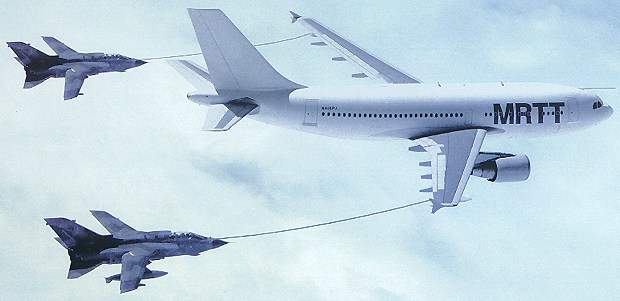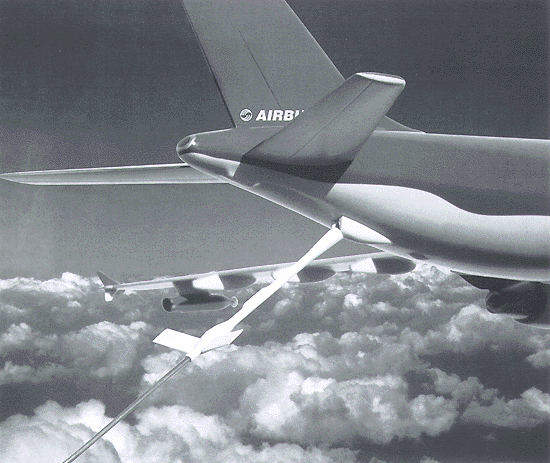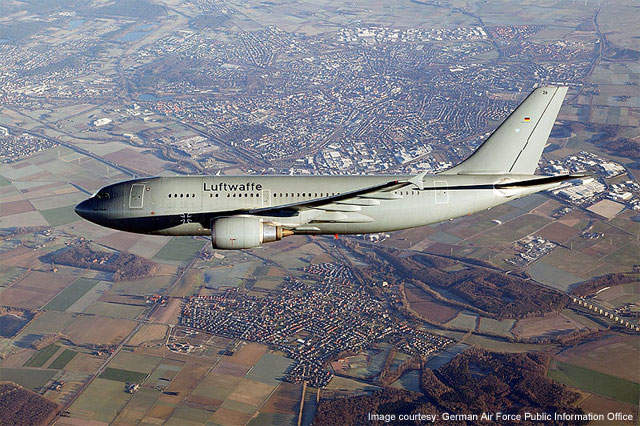The Airbus Industrie A310 MRTT is a wide-bodied multirole tanker transport aircraft derived from the Airbus A310-300 civil passenger and transport aircraft. The production of the aircraft has been terminated, but it is still in service with German and Canadian Air Forces.
The A310 MRTT can be readily converted to: air-to-air refuelling tanker, all-cargo transporter, medical evacuation aircraft, and an all-passenger transporter or combination of VIP, passenger and cargo transporter roles.
Four A310 MRTT aircraft are in service with the German Air Force. The first took its maiden flight in December 2003 and was delivered in October 2004. The A310 were already in service with the German AF as transports and aircraft conversion for in-flight refuelling was carried out by Airbus Deutschland and Lufthansa Technik.
Airbus A310 MRTT deliveries
EADS delivered the first A310 MRTT fitted with a new mission avionics package to the German Air Force in June 2007. The new mission avionics allows the A310 MRTT allocation to the NATO Reaction Forces.
Two A310 aircraft of the Canadian Air Force were converted to the MRTT configuration. The aircraft are designated CC-150 Polaris. The first was delivered in October 2004.
For the air-to-air refuelling (tanker) role, the aircraft is equipped with five centre fuel tanks or Additional Centre Tanks (ACT), and with hose and drogue pods under the outer wings. The total fuel capacity is up to 96,920l (25,605USgl), which corresponds to 77,500kg (171,000lb).
In an all-cargo transport role, the maximum non-fuel payload is 37t (81,600lb). For the troop transport role, the aircraft can provide up to 214 seats. In a combined cargo / troop transport, 12 pallets and 54 troops can be carried.
Aribus A310 MRTTT cockpit
The multi-role tanker transport is operated by a flight crew of three for all missions relating to Air-to-Air Refuelling (AAR): two pilots and the AAR operator. The AAR operator station is located in the cockpit just behind the captain. The two pilots have direct access to the majority of the information and controls concerning the AAR operational and safety aspects.
The pilots’ stations are equipped with all interfaces for control and monitoring of the ACT tanks, formation and rendezvous lights, and military avionics. This configuration allows a mission to be carried out with the AAR operator’s station switched off.
The AAR operator’s station is equipped with a fuel control panel, with fuel pump controls and fuel quantity indicators, and a dual pod control panel. The AAR operator is responsible for control of the aircraft’s rendezvous beacons and tanker illumination lights during air-to-air refuelling. The optional external video monitoring system uses infrared floodlighting for day-and-night monitoring of refuelling operations.
A310 tanker systems
The MRTT is capable of transferring 33t of fuel during a 3,000nm trail operation or 40t of fuel at 1,000nm with two hours on station. Fuel transfer during air-to-air refuelling is achieved by using the aircraft’s centre tank as a collector tank. The fuel management system and the centre of gravity computer ensure automatic tank sequencing, centre of gravity control and engine fuel feed control.
A dual refuelling pod system is installed, consisting of two Flight Refuelling Ltd Mk 32B pods mounted on pylons under each wing and a control panel in the AAR operator’s station. The total-fuel-on-board, fuel-for-dispense and individual tank quantities are displayed, together with flow rate, temperature and total fuel transferred during in-flight refuelling. Two aircraft can be refueled at the same time. 15,000l of fuel can be transferred a minute.
A flying boom system can be installed, which is capable of transferring fuel at a rate of 1,200USgl/min. Two central Hose Drum Units (HDU) installed side by side in the lower aft fuselage can dispense 800USgl of fuel a minute.
Cargo systems
The fuselage accommodates four separate cargo compartments. The large main deck compartment is loaded though a wide door on the forward left side of the fuselage. The door can be opened to the vertical position to allow loading by crane. The other three cargo compartments are below deck. Containerised and palletised loads with a pallet height up to 96in can be carried. Containers and pallets are moved by an electrically powered drive system and are locked manually.
In an air hospital role, the A310 MRTT can take up to six intensive care units and 56 stretcher cases.
Avionics
The tanker aircraft is equipped with the avionics systems installed in the A310-300 civil aircraft to ensure the operation of the tanker under civil air traffic control. The military avionics systems installed on the tanker are the V/UHF system, an IFF system and an AIR TACAN. The V/UHF system allows the aircraft to operate within the military air space control system.
The avionics suite can include a Global Positioning System (GPS), satellite communications, an Aircraft Communications Addressing and Reporting System (ACARS) and a Traffic Collision Avoidance System (TCAS).
Engines
The A310 MRTT is powered by two General Electric CF6-80C2 turbofan engines rated at 263kN of maximum thrust each. It is equipped with dual stage high pressure compressor and five-stage low pressure turbine.
The length and fan tip diameter of the engine are 4.2m and 2.69m respectively. The dry weight varies between 4,300kg and 4,472kg.
Performance
The A310 MRTT can fly at a maximum speed of 978km/h. Its range is 8,889km. The aircraft weighs around 113,999kg and its maximum take-off weight is 164,000kg.
The Global Military Aircraft Market 2011-2021
This project forms part of our recent analysis and forecasts of the global Military Aircraft market available from our business information platform Strategic Defence Intelligence. For more information click here or contact us: EMEA: +44 20 7936 6783; Americas: +1 415 439 4914; Asia Pacific: +61 2 9947 9709 or via email.








